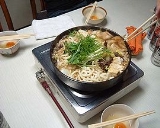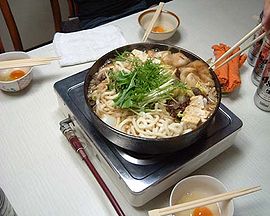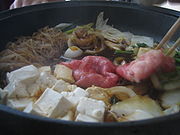
Sukiyaki
Encyclopedia


Japanese cuisine
Japanese cuisine has developed over the centuries as a result of many political and social changes throughout Japan. The cuisine eventually changed with the advent of the Medieval age which ushered in a shedding of elitism with the age of shogun rule...
in the nabemono
Nabemono
Nabemono or simply called nabe, is a term referring to all varieties of Japanese steamboat dishes, also known as one pot dishes....
(Japanese hot pot
Hot pot
Hot pot , less commonly Chinese fondue or steamboat, refers to several East Asian varieties of stew, consisting of a simmering metal pot of stock at the center of the dining table. While the hot pot is kept simmering, ingredients are placed into the pot and are cooked at the table...
) style.
It consists of meat (usually thinly sliced beef) which is slowly cooked or simmered at the table, alongside vegetables and other ingredients, in a shallow iron pot in a mixture of soy sauce
Soy sauce
Soy sauce is a condiment produced by fermenting soybeans with Aspergillus oryzae or Aspergillus sojae molds, along with water and salt...
, sugar
Sugar
Sugar is a class of edible crystalline carbohydrates, mainly sucrose, lactose, and fructose, characterized by a sweet flavor.Sucrose in its refined form primarily comes from sugar cane and sugar beet...
, and mirin
Mirin
is an essential condiment used in Japanese cuisine, consisting of 40%–50% sugar. It is a kind of rice wine similar to sake, but with a lower alcohol content—14% instead of 20%. There are three general types. The first is hon mirin , which contains alcohol. The second is shio mirin, which contains...
. Before being eaten, the ingredients are usually dipped in a small bowl of raw, beaten eggs
Egg (food)
Eggs are laid by females of many different species, including birds, reptiles, amphibians, and fish, and have probably been eaten by mankind for millennia. Bird and reptile eggs consist of a protective eggshell, albumen , and vitellus , contained within various thin membranes...
.
Generally sukiyaki is a winter
Winter
Winter is the coldest season of the year in temperate climates, between autumn and spring. At the winter solstice, the days are shortest and the nights are longest, with days lengthening as the season progresses after the solstice.-Meteorology:...
dish and it is commonly found at bōnenkai
Bonenkai
A is a Japanese drinking party that takes place at the end of the year, and is generally held among groups of co-workers or friends. The purpose of the party, as its name implies, is to forget the woes and troubles of the past year, usually by consumption of large amounts of alcohol. A bōnenkai...
, Japanese year-end parties.
Ingredients
Thinly sliced beefBeef
Beef is the culinary name for meat from bovines, especially domestic cattle. Beef can be harvested from cows, bulls, heifers or steers. It is one of the principal meats used in the cuisine of the Middle East , Australia, Argentina, Brazil, Europe and the United States, and is also important in...
is usually used for sukiyaki; although in the past, in certain parts of the country (notably Hokkaidō
Hokkaido
, formerly known as Ezo, Yezo, Yeso, or Yesso, is Japan's second largest island; it is also the largest and northernmost of Japan's 47 prefectural-level subdivisions. The Tsugaru Strait separates Hokkaido from Honshu, although the two islands are connected by the underwater railway Seikan Tunnel...
and Niigata
Niigata Prefecture
is a prefecture of Japan located on the island of Honshū on the coast of the Sea of Japan. The capital is the city of Niigata. The name "Niigata" literally means "new lagoon".- History :...
) pork was also popular.
Popular ingredients cooked with the beef are:
- TofuTofuis a food made by coagulating soy milk and then pressing the resulting curds into soft white blocks. It is part of East Asian and Southeast Asian cuisine such as Chinese, Japanese, Korean, Indonesian, Vietnamese, and others. There are many different varieties of tofu, including fresh tofu and tofu...
(usually seared firm tofu) - Negi (a type of scallionScallionScallions , are the edible plants of various Allium species, all of which are "onion-like", having hollow green leaves and lacking a fully developed root bulb.-Etymology:The words...
) - Leafy vegetables, such as Chinese cabbageChinese cabbageChinese cabbage can refer to two distinct varieties of Chinese leaf vegetables used often in Chinese cuisine. These vegetables are both related to the Western cabbage, and are of the same species as the common turnip...
and shungiku (Garland chrysanthemumGarland chrysanthemumGarland chrysanthemum, botanically Chrysanthemum coronarium or Leucanthemum coronarium, also known as chrysanthemum greens or edible chrysanthemum, is native to the Mediterranean and East Asia...
leaves). - Mushrooms such as shiitakeShiitakeThe Shiitake is an edible mushroom native to East Asia, which is cultivated and consumed in many Asian countries, as well as being dried and exported to many countries around the world. It is a feature of many Asian cuisines including Vietnamese, Chinese, Japanese, Korean and Thai...
and enokitakeEnokitakeEnokitake , also Enokidake or Enoki are long, thin white mushrooms used in East Asian cuisine . These mushrooms are cultivars of Flammulina velutipes also called golden needle mushroom... - Jelly-noodleNoodleThe noodle is a type of food, made from any of a variety of doughs, formed into long thin ribbons, strips, curly-cues, waves, helices, pipes, tubes, strings, or other various shapes, sometimes folded. They are usually cooked in a mixture of boiling water and/or oil. Depending upon the type, noodles...
s made out of konnyaku cormCormA corm is a short, vertical, swollen underground plant stem that serves as a storage organ used by some plants to survive winter or other adverse conditions such as summer drought and heat ....
such as ito konnyaku or shirataki noodlesShirataki noodlesare very low carbohydrate, low calorie, thin, translucent, gelatinous traditional Japanese noodles made from devil's tongue yam . The word "shirataki" means "white waterfall", describing the appearance of these noodles...
. It is said to be advisable to place these away from the beef because the calcium contained in the noodles can toughen meat.
Boiled wheat udon
Udon
is a type of thick wheat-flour noodle of Japanese cuisine.Udon is usually served hot as noodle soup in its simplest form as kake udon, in a mildly flavoured broth called kakejiru which is made of dashi, soy sauce , and mirin. It is usually topped with thinly chopped scallions...
or soba
Soba
is the Japanese name for buckwheat. It is synonymous with a type of thin noodle made from buckwheat flour, and in Japan can refer to any thin noodle . Soba noodles are served either chilled with a dipping sauce, or in hot broth as a noodle soup...
(buckwheat) noodles are sometimes added, usually at the end to soak up the broth.
Preparation
Like other nabemono dishes, each region has a preferred way of cooking sukiyaki. The key difference is between the western KansaiKansai
The or the lies in the southern-central region of Japan's main island Honshū. The region includes the prefectures of Mie, Nara, Wakayama, Kyoto, Osaka, Hyōgo, and Shiga. Depending on who makes the distinction, Fukui, Tokushima and even Tottori Prefecture are also included...
region and the eastern Kantō region. In Tokyo
Tokyo
, ; officially , is one of the 47 prefectures of Japan. Tokyo is the capital of Japan, the center of the Greater Tokyo Area, and the largest metropolitan area of Japan. It is the seat of the Japanese government and the Imperial Palace, and the home of the Japanese Imperial Family...
, the ingredients are stewed in a prepared mixture of soy sauce
Soy sauce
Soy sauce is a condiment produced by fermenting soybeans with Aspergillus oryzae or Aspergillus sojae molds, along with water and salt...
, sugar
Sugar
Sugar is a class of edible crystalline carbohydrates, mainly sucrose, lactose, and fructose, characterized by a sweet flavor.Sucrose in its refined form primarily comes from sugar cane and sugar beet...
, sake and mirin
Mirin
is an essential condiment used in Japanese cuisine, consisting of 40%–50% sugar. It is a kind of rice wine similar to sake, but with a lower alcohol content—14% instead of 20%. There are three general types. The first is hon mirin , which contains alcohol. The second is shio mirin, which contains...
, whereas in Osaka
Osaka
is a city in the Kansai region of Japan's main island of Honshu, a designated city under the Local Autonomy Law, the capital city of Osaka Prefecture and also the biggest part of Keihanshin area, which is represented by three major cities of Japan, Kyoto, Osaka and Kobe...
, the meat is first grilled in the pan greased with tallow
Tallow
Tallow is a rendered form of beef or mutton fat, processed from suet. It is solid at room temperature. Unlike suet, tallow can be stored for extended periods without the need for refrigeration to prevent decomposition, provided it is kept in an airtight container to prevent oxidation.In industry,...
. After other ingredients are put over these, the liquid is poured into the pan. The shungiku are added when all the ingredients are simmering. A raw egg is broken into a serving bowl, one egg for each person. Some prefer to add a bit of soy sauce and the egg is lightly beaten. The meat and vegetables are dipped into this sauce before being eaten.
History
Some anecdotes are known about the early history of sukiyaki. One is about a medieval nobleman. He stopped at a peasant's hut after a hunt and ordered him to cook the game. The peasant realized that his cooking utensils were improper for the noble, so he cleaned up his spadeSpade
A spade is a tool designed primarily for the purpose of digging or removing earth. Early spades were made of riven wood. After the art of metalworking was discovered, spades were made with sharper tips of metal. Before the advent of metal spades manual labor was less efficient at moving earth,...
(suki in Japanese) and broiled (yaki) the meat on it. Another story is about the Portuguese in the sixteenth century in Japan, where beef was not common food. They eagerly ate meat everywhere, even on suki.
Another history is that peasants would cook sweet potatoes in the field, doing so in their spades they would need to carry less gear.
In the 1860s when Japan was opened to foreigners, new cooking styles were also introduced. Cows, milk, meat, and eggs became widely used, and sukiyaki was the most popular way to serve them. The first sukiyaki restaurant, Isekuma, opened in Yokohama
Yokohama
is the capital city of Kanagawa Prefecture and the second largest city in Japan by population after Tokyo and most populous municipality of Japan. It lies on Tokyo Bay, south of Tokyo, in the Kantō region of the main island of Honshu...
in 1862.
Beef is the primary ingredient in today's sukiyaki. There were two main ways of cooking sukiyaki: a Kantō
Kanto region
The is a geographical area of Honshu, the largest island of Japan. The region includes the Greater Tokyo Area and encompasses seven prefectures: Gunma, Tochigi, Ibaraki, Saitama, Tokyo, Chiba, and Kanagawa. Within its boundaries, slightly more than 40 percent of the land area is the Kantō Plain....
(Tokyo
Tokyo
, ; officially , is one of the 47 prefectures of Japan. Tokyo is the capital of Japan, the center of the Greater Tokyo Area, and the largest metropolitan area of Japan. It is the seat of the Japanese government and the Imperial Palace, and the home of the Japanese Imperial Family...
area) and a Kansai
Kansai
The or the lies in the southern-central region of Japan's main island Honshū. The region includes the prefectures of Mie, Nara, Wakayama, Kyoto, Osaka, Hyōgo, and Shiga. Depending on who makes the distinction, Fukui, Tokushima and even Tottori Prefecture are also included...
(Osaka
Osaka
is a city in the Kansai region of Japan's main island of Honshu, a designated city under the Local Autonomy Law, the capital city of Osaka Prefecture and also the biggest part of Keihanshin area, which is represented by three major cities of Japan, Kyoto, Osaka and Kobe...
area) style. In the Kantō way, the special cooking sauce's ingredients are already mixed. In the Kansai way, the sauce is mixed at the time of eating. But after the great Kanto earthquake
1923 Great Kanto earthquake
The struck the Kantō plain on the Japanese main island of Honshū at 11:58:44 am JST on September 1, 1923. Varied accounts hold that the duration of the earthquake was between 4 and 10 minutes...
of 1923, the people of Kantō temporarily moved to the Osaka area. While the people of Kantō were in Osaka, they got accustomed to the Kansai style of sukiyaki, and when they returned to Kantō, they introduced the Kansai sukiyaki style, where it has since become popular.
Thai suki
A hot potHot pot
Hot pot , less commonly Chinese fondue or steamboat, refers to several East Asian varieties of stew, consisting of a simmering metal pot of stock at the center of the dining table. While the hot pot is kept simmering, ingredients are placed into the pot and are cooked at the table...
dish called Thai suki
Thai suki
Thai suki, known simply as suki in Thailand, is a Thai variant of hot pot, a communal dish where diners dip meat, seafood, noodles, dumplings and vegetables into a pot of broth cooking at the table and dip it into a spicy "sukiyaki sauce" before eating...
or Thai sukiyaki is very popular in Thailand
Thailand
Thailand , officially the Kingdom of Thailand , formerly known as Siam , is a country located at the centre of the Indochina peninsula and Southeast Asia. It is bordered to the north by Burma and Laos, to the east by Laos and Cambodia, to the south by the Gulf of Thailand and Malaysia, and to the...
and, increasingly, neighboring countries. Despite the name, it bears only a vague resemblance to Japanese sukiyaki.

